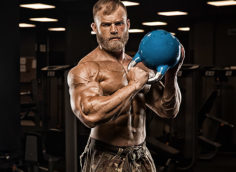Traditional fitness writers and coaches have tried to convince you that weight-training for either maximal strength or hypertrophy are two separate entities. This couldn't be further from the real truth. If I ever try to get a straight answer for their reasoning, I usually hear something along the lines of, "Powerlifters don't get big muscles like bodybuilders. Therefore, training heavy with low reps doesn't build as much muscle."
Folks, let me tell you, that's stupidity spelled with a capital "S."
One of the keys to my success in this industry relates to the fact that my clients possess outstanding levels of maximal strength. Regardless if my client's goal is hypertrophy, fat loss, or endurance, I'm always thinking about maximal strength levels first.
In other words, the three aforementioned goals usually cause dramatic decreases in maximal strength levels due to the type of "traditional" parameters that most trainers and coaches follow. Therefore, when I design a program for hypertrophy, fat loss, or endurance, I first consider how I'm going to avoid decreasing maximal strength in pursuit of the other goals. This has been a very valuable tool in my arsenal and now you're going to reap the benefits of this thought process for maximum hypertrophy!
I frequently ask readers and fellow lifters what their favorite set/rep parameters are for hypertrophy. Usually, I get a deluge of responses within the narrow range of 3-6 sets and 8-15 reps per muscle grouping. (Keep in mind, these are usually the same fellas who can still buy their T-shirts off the children's rack). I don't think I've ever asked a trainee that question and received this response, "Best rep range for hypertrophy? Well, singles of course!"
Well, I'm here to exploit the virtues of singles. They're the most underrated parameter in all aspects of hypertrophy training. The recent push of ill-conceived time-under-tension guidelines for hypertrophy has probably added to the close-minded thought process in today's hypertrophy parameters. After all, performing a single repetition usually takes only 2-4 seconds per set, so how beneficial can they be for hypertrophy? Immensely beneficial is what I say. In fact, more beneficial than you ever imagined!
The Genesis of Singles in Waterbury's Programs
Much of what I've learned about strength-training stemmed from my observations while growing up on farms and ranches. When I became a professional strength-trainer, I realized many of the exercises I created paralleled actions I'd performed or seen out on those wide open pastures. But I took things a step further.
I also paid close attention to the ranch-hands who had the greatest levels of muscle and maximal strength. I realized they frequently performed short-duration activities that involved the recruitment of many large muscle groups. I also noticed they didn't perform more than one or two repetitions of anything before taking a short break. Chores such as tossing hay bales, lifting big ol' truck tires, and turning a huge tire iron to replace a tractor tire are all good examples. I figured if these parameters worked for them, then they could probably work for my clients and me, too.
Damn, was I right!
Why Singles Work
Trainees have been lifting large loads for a single repetition since the beginning of time, but rarely was it ever considered a technique for hypertrophy. In fact, many strength coaches don't think singles will cause any hypertrophy. But I can tell you they're wrong – dead wrong. Singles work extremely well for a variety of reasons, but I'll touch on a few of the most important:
1. Improved Form through the Law of Repetition – The more frequently you perform a single, the better your technique will become, and consequently the more weight you'll be able to lift. This does not mean fifteen repetitions are fifteen times more effective than singles for improving your form. In fact, proper technique breaks down so quickly in a traditional high-repetition set that this type of training usually causes poorer technique. Using the squat as an example, the more times you can set up under the bar, step back and set your stance, lower into the squat and explode up, the better!
2. Proper Motor Unit Recruitment – Singles allow you to utilize an extremely large load. The heavier the load, the more fast-firing/fast-fatiguing, growth-supercharging motor units you'll recruit.
3. Reduced Central Nervous System (CNS) Fatigue – Intuitively, this doesn't make much sense, but singles are relatively easy on the central nervous system if the trainee performs them correctly. This program revolves around singles performed with a 3RM (repetition maximum) so there's no grunting and screaming involved. This is extremely important because CNS fatigue must be controlled or else overtraining will occur in a New York minute.
4. Reduced Peripheral Nervous System (PNS) Fatigue – Singles don't cause a dramatic build-up in lactic acid within the muscles, therefore fatigue is minimized. Because of this, numerous singles can be performed in a single training session if the rest periods are adequate.
Why Aren't Many Powerlifters More Muscular?
It's true that some super-strong powerlifters don't have appreciable amounts of muscle tissue compared to their strength levels. But when these same powerlifters quit competing and switch over to "bodybuilding" methods, they pack on some serious muscle. Is that proof that powerlifting methods don't build muscle? Hell no! Here's my thought process on the issue:
1. Many powerlifters perform old-school set/rep parameters such as 3 x 3, 4 x 2, and 6 x 1 along with long (~5 min.) rest periods for their competition lifts. With volumes like that, very few trainees will ever add significant amounts of muscle tissue. The volume is too damn low! If they upped the volume (i.e., performed more sets), hypertrophy would skyrocket. In other words, one of the main reasons why traditional powerlifters don't hypertrophy is due to the fact that their session volume is too low.
Note: Sometimes powerlifters want to stay in a certain weight class so excess hypertrophy (weight gain) isn't something they want.
2. Powerlifters who seek hypertrophy by performing a greater volume are able to better recruit high-threshold motor units. This leads to massive hypertrophy. Remember, high levels of maximal strength will allow you to build more muscle due to more efficient motor unit recruitment once the volume is increased.
3. Many powerlifters lift super fast. Increasing your speed increases your ability to develop maximal strength. Developing maximal strength leads to better capabilities to gain muscle, period.
Hopefully, that's enough evidence to convince you. Let's take a look at a program that's going to escalate hypertrophy and maximal strength!
Day 1
Method: Hypertrophy Strength Singles (lower body)
Sets: 14
Reps: 1
Load: 3RM
Rest: 60s between sets
Tempo: As fast as possible while controlling the eccentric phase
Exercises:
A. Barbell Back Squats
B. Back Extensions (clutch a plate to your chest to add resistance)
C. Seated Calf Raises
Note: Perform all 14 sets for squats before moving on to back extensions and then finish with seated calf raises. Rest 3 minutes between exercises.
 |
 |
| Back Extensions |
Day 1 utilizes a 3RM load. This is very important since a true 1RM load would not allow you to finish all 14 sets. You shouldn't feel fatigued until the last few sets, and this is the reason why the CNS stays fresh on this program. You must avoid training to failure. If your neuromuscular efficiency is low and you can't perform all 14 sets with a 3RM, decrease the load by 2.5% for the next session and all should be well.
Day 2
No weight-training. Perform 15-20 minutes of jogging or uphill treadmill walking (if your calves are lagging).
Day 3
Method: Endurance/Hypertrophy Strength (upper body)
Sets: 3
Reps: 18
Load: 20RM
Rest: 60s between antagonist sets
Tempo: Fast, under control
Exercises:
A1. Chin-ups
A2. Flat DB Bench Press
B1. Barbell Curls
B2. Barbell Skull Crushers
Note: Alternate between chin-ups and flat DB bench presses for three cycles with 60s rest periods. Rest 3 minutes and move on to barbell curls and skull crusher antagonist supersets for three cycles.
Day 3 parameters might have you scratching your head. With all this talk of maximal strength levels, you're probably wondering why this day utilizes such high repetitions. Even though I did my best to minimize CNS fatigue on the single's day, fatigue is still inevitable. This day must be as different from Day 1 as possible in order to minimize overtraining. If I chose something along the lines of 5 x 5 on Day 3, you'd burn out in no time.
Day 4
Method: Endurance/Hypertrophy Strength (lower body)
Sets: 3
Reps: 18
Load: 20RM
Rest: 90s between antagonist sets
Tempo: Fast, under control
Exercises:
A1. Barbell Deadlifts
A2. Standing Calf Raises
B1. Lying Leg Curls
B2. Hanging Pikes
Note: Alternate between traditional barbell deadlifts (feet shoulder-width, grip bar with pinky fingers around the ring) and standing calf raises using 90s rest periods. Rest 3 minutes and alternate between lying leg curls and hanging pikes using 90s rest periods for three cycles.
 |
 |
| The Hanging Pike | |
Day 5
No weight-training. Perform 15-20 minutes of jogging or incline treadmill walking.
Day 6
Method: Hypertrophy Strength Singles (upper body)
Sets: 14
Reps: 1
Load: 3RM
Rest: 60s between sets
Tempo: As fast as possible while controlling the eccentric phase
Exercises:
A. 15-20 degree Incline Barbell Bench Press,
B. Chest-supported Rows (palms supinated for biceps activation)
C. Dips
Note: Perform all 14 sets for incline barbell bench presses before moving on to chest-supported rows and then finish with dips. Rest 3 minutes between exercises.
Day 7
Off completely
Day 8
Repeat cycle for three more weeks.
Progression:
For weeks 2-4, add one set to each single's workout for all movements. In other words, Day 1 on week 2 will utilize 15 sets of 1 repetition; Day 1 on week 3 will utilizes 16 x1; Day 1 on week 4 utilizes 17 x 1. The same holds true for Day 6.
Increase the load of Days 3 and 4 by 2.5% each week for all sets.
Conclusion
I hope y'all are sick and tired of losing maximal strength in pursuit of hypertrophy. Give this program a shot because it works incredibly well for hypertrophy. At the same time, you'll get the added benefit of increased maximal strength so you can back up your newfound size with improved maximal strength. Afterwards, if you want a job baling hay, let me know.




